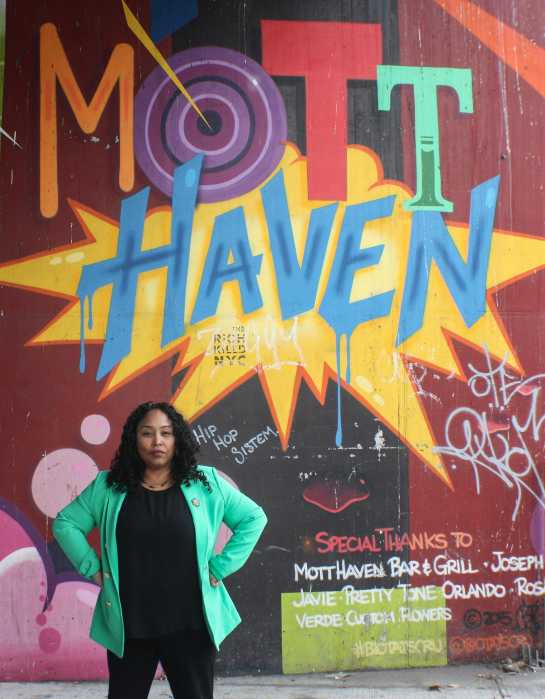By Lincoln Anderson
The new life sciences building that John Sexton, New York University’s president, last year said the school needed will not be located on the Morton Williams supermarket site — N.Y.U.’s main development property at Bleecker St. and LaGuardia Pl.
Instead, N.Y.U. announced this week it plans to do a gut renovation of three buildings it owns on Waverly Pl. between Greene and Mercer Sts., east of Washington Sq. — 12, 14 and 16 Waverly Pl. — to create a new, 35,000-sq.-ft. life sciences building for genomics, or the study of how genes function.
Lynne Brown, N.Y.U. senior vice president, and Michael Haberman, N.Y.U. director of government and community relations, spoke to The Villager on Monday about the project.
The three buildings are roughly six-stories, former factory buildings, according to Haberman. The community-facilities allowance — which permits added bulk for buildings owned by nonprofit organizations — will be employed for the project, he said. Haberman said while plans are only preliminary, two stories will be added above the existing roofline, though there will be a setback, so the addition won’t be visible from the street.
“It won’t be the highest building on the block,” said Haberman. “It will be shorter than the building next to it,” he added, though noting that the ceiling height of the two additional stories might be taller than usual since they will be labs.
Brown said that the use of the existing buildings, whose facades will be preserved, shows that President Sexton and the university are making a genuine effort to house new facilities in properties N.Y.U. owns, rather than putting up new buildings.
“At least where possible,” she said, “we’re trying to be very efficient and creative in our use of existing space…. We had in mind some of the guidance we got from community meetings.”
The buildings are not in the Greenwich Village Historic District.
Back offices will be moved out to make way for the new facility, which will focus on the field of comparative functional genomics. Scientists will study genes in worms, fruit flies and plants that are common in humans in order to gain insight on things like disease and aging.
Brown described it as a relatively “clean science,” in that there are no significant chemicals involved. Much of the operation will involve computers and “number crunching,” she said.
Gloria Coruzzi, chairperson of N.Y.U.’s Biology Department, said genomics offers exciting research possibilities. Forty percent of genes in fruit flies and humans and 30 percent of genes in certain weeds and humans are common, she noted.
“I think it’s fantastic. I just wish it was bigger,” Coruzzi said of the planned building.
The site is conveniently located near N.Y.U.’s Brown Building, its main science center.
N.Y.U. recently received a $5 million grant from the federal National Science Foundation, which will go to the new sciences program.
The new facility is hoped to be completed by 2007. Work will start in spring or early summer of 2005.
Since it involves living organisms and plants, the program will have a partnership with the Museum of Natural History and the New York Botanical Garden, as well as other institutions. Brown said the facility won’t involve traditional animal research.
Brown and Haberman said there will be a town hall meeting sometime before N.Y.U.’s winter break at which the community will be able to meet with architects for the project, which is still in preliminary designs.
As for the Morton Williams site, Brown said it’s of course still a development location for N.Y.U., but that these particular type of life sciences will not go there now. Faculty and student housing, classrooms and other labs are all possibilities, she said.
Haberman said the university notified elected officials and community board leaders about the new project prior to putting out a press release on Tuesday.
However, Andrew Berman, executive director of the Greenwich Village Society for Historic Preservation, said he wished he’d been notified directly, instead of having had the press release forwarded to him from someone else. Berman also wondered what happened to the comprehensive development planner for the university that Sexton at his first town hall meeting a year and a half ago said N.Y.U. would be hiring.
"The science building has come before they hired the planner,” Berman noted.
Trying to take a proactive approach on the Morton Williams site, Community Board 2 has set up a working group to study the issue and make some recommendations to N.Y.U. for what they’d like to see there.
“We’re meeting as a group of concerned citizens who live around here,” said Jim Smith, Board 2’s chairperson, adding they won’t be wearing their community-group hats.
“It’s an informal group that will meet maybe once, twice or three times, to see what’s the least objectionable that can be built there,” he said. “It is not binding on N.Y.U. It is not binding on us. It’s just to give N.Y.U. some feel for what the limits of our tolerance for certain ideas [would be].”






























